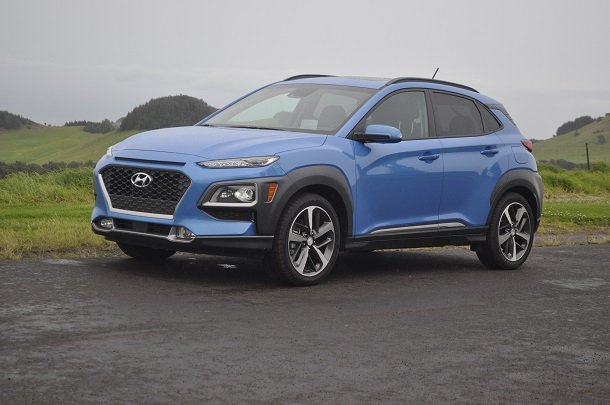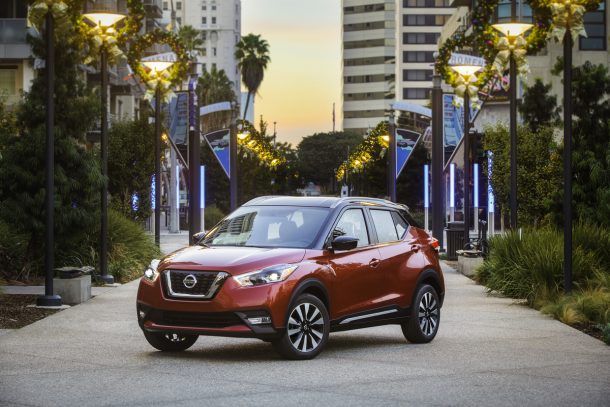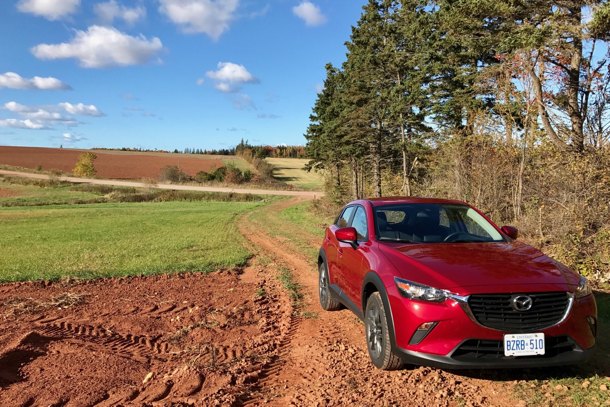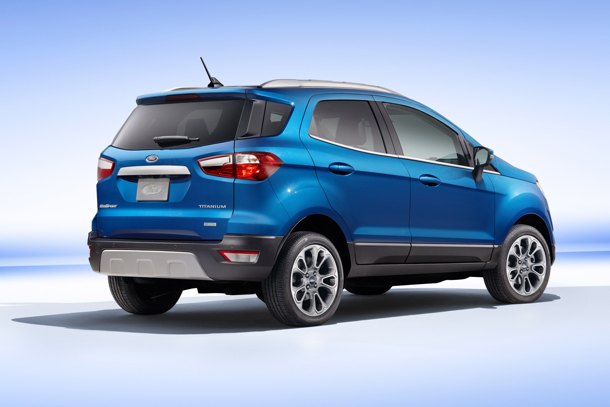#SubcompactCrossovers
March 2018 U.S. Auto Sales: Ford EcoSport Still Climbing, but so Are Other Mainstream Subcompact Crossovers
The Ford EcoSport, a new (to North America) subcompact crossover hastily inserted at the bottom of the Blue Oval’s lineup, went on sale in January of this year. No TTACer who sat in the vehicle at the North American International Auto Show in Detroit walked away impressed, and it was odd to see a new model introduction go without the obligatory first drive event.
Still, the vehicle, which starts at a hair under 20 grand and carries a 1.0-liter three-cylinder as a base powerplant, isn’t being ignored by the buying public. March EcoSport sales in the U.S. topped that of the well-regarded — but not especially capacious — Mazda CX-3. Still, as all things truck continue to garner ever greater market share in the U.S., the little Ford faces a difficult upward climb.
2018 Hyundai Kona First Drive - Content Comes at a Price
It’s probably a little too on the nose for any automaker to launch a car in the city, state, or region it’s named after, but that didn’t stop Hyundai from bringing media to Hawaii to drive the newest entry into the subcompact crossover class.
Hyundai did so not just because of the “synergy” (ugh) between place and name, but because the company wanted to show us scribes how sporty and fun and well-suited to outdoorsy folk the Kona is. Never mind that most compact SUV buyers aren’t hauling long boards – they’re hauling little humans.
Every automaker does this — projecting their crossovers as the key to adventure. And I have no doubt that equipped with the correct accessories, the Kona can haul your bikes to the trailhead just fine. But most of these are going to be found in traffic on city streets, just like most of the crossovers buyers will cross-shop against the Kona.
The bigger question, then, is where does the Kona fit in a segment Hyundai calls the “Wild West?”
With the UX, Lexus Now Has a Finger In Every Utility Vehicle Pie
The only thing missing is a cabriolet. With the unveiling of its new UX subcompact (“urban compact crossover” in Lexus parlance), Toyota’s premium division now spans the utility segment gamut, with models ranging from ultra-small unibodies to full-size, body-on-frame luxo-barges.
Lexus’ European arm pulled the wraps off the UX on Tuesday, ahead of the global model’s world premiere in Geneva next week. In the model’s sights are a trio of pint-sized Germans and a singular Japanese foe, all competing for a slice of a segment with unclear growth prospects.
Hyundai Kona Rolls Out of the Gate With a Less-than-ideal Lease
As we told you earlier this month, Hyundai’s newest offering, the B-segment Kona crossover, arrived with a base price below that of its subcompact competition. At $20,450 after delivery for a base, front-drive SE, the Kona slots below the entry MSRPs of the Honda HR-V, Toyota C-HR, Chevrolet Trax, and Mazda CX-3.
Value, the Kona trumpets, has arrived.
Well, not if you’re leasing the Kona’s volume trim: the SEL model.
Hyundai Releases Kona Pricing, Positions Subcompact Crossover As Value Leader
We’ll have to wait until Nissan releases pricing for its weirdly named Kicks before we can declare the 2018 Hyundai Kona the least-expensive subcompact crossover in America, but that’s the way it is for now.
The Korean automaker released its pricing list for the Kona on Wednesday, revealing a vehicle that undercuts every one its American and Japanese rivals in entry cost. Starting price for a Kona? $20,450 after delivery for a front-wheel-drive SE model.
Fuel Economy Figures Released for Hyundai's Littlest Crossover
Hyundai’s smallest utility vehicle arrives as the automaker tries to put a troubling year behind it. Sales fell significantly in both the U.S. and Canada in 2017, the first annual drop since the recession. The blame for the 13.4 percent U.S. drop and 6.1 percent Canadian decline lies in our growing aversion to small, fuel-efficient cars, of which Hyundai has many, and our insatiable lust for large utility vehicles, of which Hyundai does not have enough.
There’s nothing large about the Hyundai Kona, but it’s still an important player in the raft of new or revamped crossovers bound for Hyundai’s stable. And, just like in the small car segment it’s slowly replacing, economy matters in the small crossover segment. So, now that the Environmental Protection Agency has seen fit to test the Kona, how does its thirst stack up against its rivals?
Subcompact Crossovers Are Depreciating Faster Than Any Other Segment
Remember how Beanie Babies were a national phenomenon in the mid-1990s? The country couldn’t seem to get enough of the little darlings and many ended up going for astronomical prices. But, like most stupid trends, their popularity was short lived. It wasn’t long before the once-collectible toys held the same value as a used pair of underwear.
Subcompact crossovers may be suffering a similar fate. With the CUV craze in full tilt, automakers have been capitalizing by providing budget-minded shoppers with small and affordable variants. However, the group currently faces the heaviest depreciation of any automotive segment.
Topical: Nissan's Okay With a Front-drive Crossover, but Toyota Has Regrets
This morning’s Question of the Day was all about all-wheel drive and which models could stand a dose of four-wheel traction. So far, no one’s talking about the Nissan Versa Note.
Nissan, however, is more than happy to talk about the fact that its upcoming Kicks subcompact crossover will arrive with power relegated only to the front wheels. Hardly a brawny setup for a high-riding vehicle, but the automaker doesn’t seem to care much about the buyers it might be leaving behind. Toyota, on the other hand, harbors lingering regrets over its entry in the B-segment class, the C-HR.
Acura Drops Another Hint of a U.S.-bound CDX
Officially, there is no word. Unofficially, Acura seems plenty content with the idea of bringing the Chinese-market CDX subcompact crossover to North America, so long as there’s a business case for it.
“It’s a model that interests a lot of our people, so we have our R&D guys looking into the possibility,” said Jon Ikeda, vice president of American Honda’s Acura division, last April.
Is an American design patent granted to Honda proof that the company’s braintrust have made up their minds?
U.S. Dealers Plead for a Smaller Lexus Crossover
If American dealers get their way, Lexus’ planned subcompact crossover — first shown in concept form last year — won’t be the strictly Europe-focused proposition the brand’s parent company intended.
The UX concept, introduced at the 2016 Paris Auto Show, shares its architecture with the Toyota C-HR and is already scheduled for production. We’ll see the model debut in Geneva next March. Lexus Europe is positioning the model as a new entry point for the brand’s utility lineup, designed to appeal to urbanites used to navigating tight spaces.
But European city-dwellers aren’t the only ones who took notice of the UX concept. Dealers in the U.S. are clamoring for a chance to bulk up their growing lineup with something small. It’s something Lexus is now considering.
Get Yer Kicks: Nissan's Latest Utility Vehicle Will Soon Be Its Tiniest
The dubious long-term sales potential of the subcompact crossover segment isn’t swaying Nissan from introducing a B-segment vehicle in the United States. The automaker’s seventh utility vehicle, carrying the youthful name Kicks, debuted at the L.A. Auto Show today.
The Kicks is the only way Americans can take home any part of a Nissan Micra, as the diminutive crossover rides atop a second-generation version of that vehicle’s platform. The first-generation platform, you’ll recall, underpinned the funky Nissan Juke. That model, known for its polarizing styling, isn’t long for this world.
In its place, the Kicks offers slightly larger dimensions and — most importantly — safe and modern styling.
There Just Might Be a Kona Under the Tree This Christmas
Desperate eager to fill holes in its product lineup and put some bounce in its sales step, Hyundai unveiled the subcompact Kona crossover earlier this year, with the model arriving on North American shores in the first quarter of 2018. The Kona is just one part of Hyundai’s revamp of its crossover lineup — and its culture.
More crossovers, bigger and smaller crossovers, EV crossovers, and faster crossovers make up Hyundai’s short-term goals. By “faster,” we’re referring to the development cycle, unless the brand has some hot “N” action waiting for one of its cargo-friendly models. Caught off guard by the utility vehicle craze, Hyundai wants to pare its product planning window down from three years to a year-and-a-half, allowing a quicker response to new market trends.
But the first step towards a more agile Hyundai Motor Company is the Kona. Small, cladded, and efficient, the 2018 Kona might arrive sooner than planned.
2018 Mazda CX-3 GX Manual Review - Three Pedals Only Enhance the CX-3's Best Characteristics
Does it matter that I think it’s a hatchback? In the minds of the consumers Mazda is targeting, the modestly updated 2018 Mazda CX-3 is a crossover, an ess-you-vee, a utility vehicle.
We ought to make some allowance for the designation differences. The Mazda CX-3 offers all-wheel drive. The wheelarches are cladded in black plastic. The loftier ride height creates 6.1 inches of ground clearance, up from 5.5 inches in the Toyota Yaris iA, which is essentially a Toyota-branded sedan version of the latest Mazda 2 (that’s never been sold in the United States) on which the CX-3 is also based.
Let’s give in to Mazda’s marketing for a moment, then. If the CX-3 “may lead to spontaneous excursions,” how will it respond to a harvest season visit into Prince Edward Island’s endless reserve of potato fields?
To make matters more interesting, our CX-3 steed lacks Mazda’s optional all-wheel drive as well as Mazda USA’s standard automatic transmission. Count’em: there are three pedals.
QOTD: What's the Worst Automotive Segment?
There’s no need for detail. Nuance is unnecessary. Set aside demands for specifics.
What’s the worst type of vehicle known to humankind in 2017?
There are leaders in every category, of course. But the fact that the Ford Transit Connect is surprisingly fun to drive doesn’t make the small commercial van sector particularly appealing. Likewise, there are laggards in every category, too. Yet the Mitsubishi Lancer’s uncompetitive nature doesn’t cast a broad brush across the entire compact sedan segment.
Somewhere, however, in some corner of the vast U.S. auto industry, resides an entire segment of vehicles that is, as of 2017, the worst. It’s the segment that provides the worst return-on-investment. The vehicles in said segment haven’t moved the game forward in the same way full-size pickup trucks or American muscle cars have their own category. There’s no obvious class leader or class embarrassment because every vehicle in the category lacks true sensibility.
What vehicle category are we talking about?
Mazda CX-3 Wants to Save the Manuals, Too
Every Sunday or Monday, a very generous man appears in my driveway with a new car. The same man, in not as generous a fashion, also removes a car from my driveway. The most recent exchange involved the arrival of a fourth-generation 2018 Kia Rio and the departure of the 2018 Mercedes-Benz E400 4Matic Coupe we reviewed last week.
“Chilly one today, eh?” I say.
“I’m preparing myself for some cold days in PEI this winter,” Mr. Sowerby says with a chuckle. We chat for a moment about a recent Chevrolet Traverse event that was slathered across my Twitter feed, and as Garry gets into the Mercedes-Benz to depart he says, “You’re getting a Mazda CX-3 with a six-speed stick next week.”
Huh? It can’t be. Seriously?
For real.




























Recent Comments